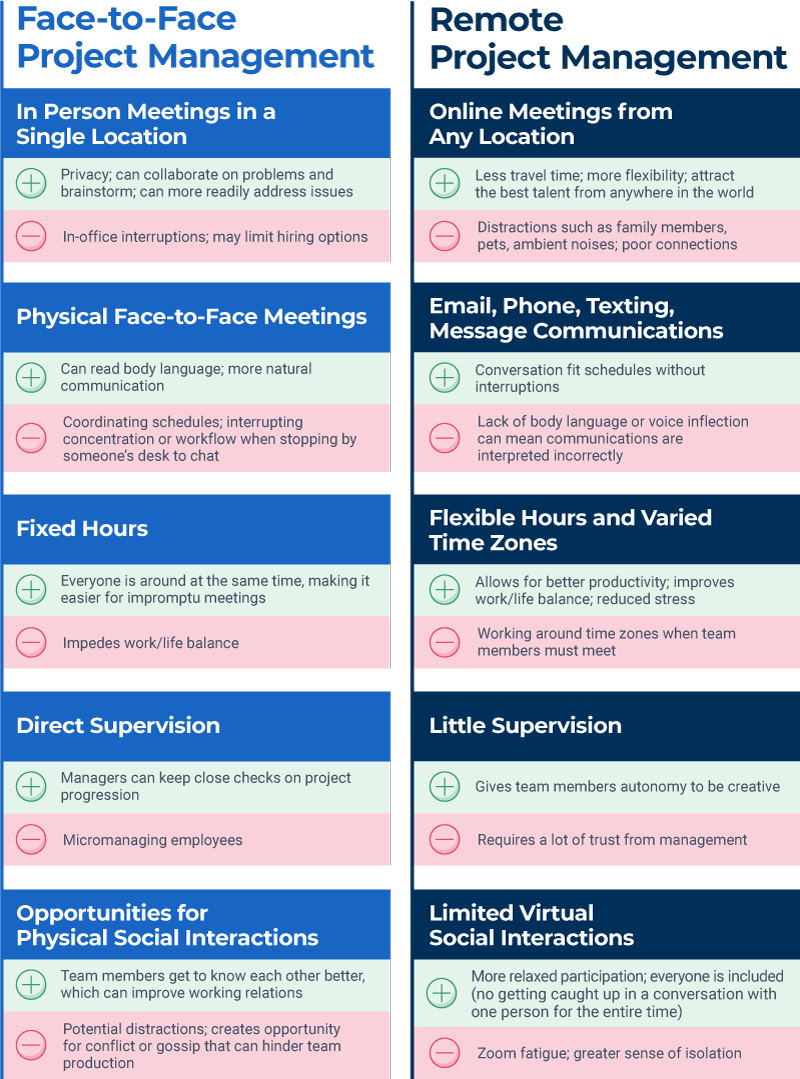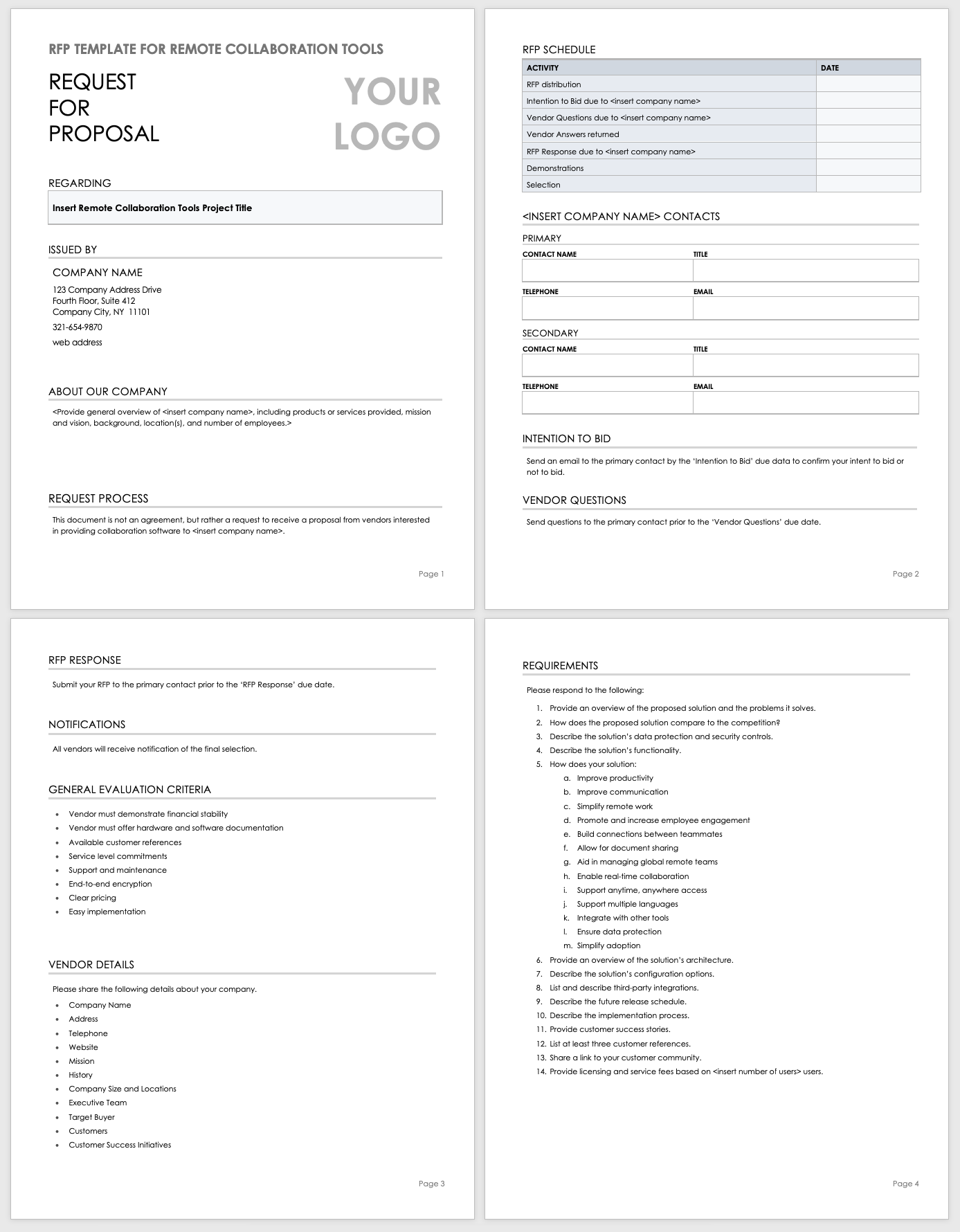What Is Remote Project Management?
Remote project management refers to the management and coordination of project deliverables completed by a geographically distributed team, often without in-person interactions. The goal is the same as that of traditional project management: to deliver the end project within the specified requirements.
Ever since the internet enabled collaborative remote work, teams that include members in different locations – or, in some cases, all around the world – have been the norm. However, this dynamic heightens under certain circumstances, such as a global pandemic, that reveal how easy it is for employees to work remotely — but also how difficult it is to manage projects among a distributed workforce. To succeed, remote project managers must take a different approach than they would with more traditional project management.
Remote Project Management Teams and Roles
Remote project managers require the same skills as traditional project managers — attention to details and solid people management skills — but they also need the ability to lead from a distance.
There are three types of remote teams in project management:
- Fully Remote Teams: In this setup, everyone on the team works in different remote locations.
- Hybrid Teams: These teams place some members of the group in a home office while the rest of the team works from remote locations.
- Flex Teams: Members of these teams have flexibility in their work location — they can be in the same workspace or remote areas. The structure of this team may continuously change.
A remote project manager’s role is to oversee each of these types of teams. They are responsible for delegating assignments across the team, perhaps for employees with whom they have never interacted in person. They should be able to deftly handle the cloud-based project management tools the team uses and keep projects within budget. And, perhaps most important, the remote project manager needs to have excellent communication skills to ensure the project moves forward on time and everyone on the team pulls their weight.
Remote Project Management Best Practices
Although the project management process will remain the same with initiation, planning, execution, monitor and control, and project completion, project management for remote teams requires new strategies that support communication and collaboration to achieve the end goal. These remote project management tips for success include the following:
- Develop Standards for Communications, Metrics, and Goals:
“One of the most critical aspects of project management practice is communication,” says Mary Beth Imbarrato, Owner of MBI Consulting. “Communication makes up 90 percent of a project manager's role, yet communication continues to be one of the top five reasons for project failure, based on statistics from the Project Management Institute. You can effectively manage projects remotely if you have a comprehensive, meaningful, and sustainable communication plan.”
To ensure regular communication between manager and team members, establish regular check-in meetings — these interactions can happen on video chat where everyone can see each other and share project updates. Because no one wants to be fatigued from too many online meetings, they should be short and to the point, and include only those who need to be on the call. Provide an agenda beforehand to allow team members to prepare and to stay on topic. Sometimes, you’ll have to juggle time zones in order to facilitate this type of remote communication. Try to be considerate to all team members, with the knowledge that everyone must accept that sometimes they’ll have to jump on a call during traditional non-work hours.
Project managers shouldn’t be afraid to over-communicate every detail of the project and its timeline. You can’t assume your team has everything they need or knows the project at the intimate level you do. It is better to over-clarify information than to miss important details. Also, assure your team that the purpose of these guidelines is to keep the project moving forward, not because of a lack of trust in their ability to get their work done. Peruse the MBI Consulting library for more resources. “In addition to understanding the context of your project, it is also important to ensure your team members understand where their work fits into the broader business context,” says Dave Garrett, Chief Strategy & Growth Officer at The Project Management Institute. “By providing a big-picture context — strategic ties, business priorities, stakeholder perspectives, other projects in flight, industry shifts, etc. — all team members can better understand the specific outcomes they need to deliver. This clarity can help create a high-trust environment, which is especially important when there is less face-to-face contact.
”Communication is a two-way street. Just as project managers must reach out to their team members, they must also be willing to listen to any feedback and take action to remedy concerns quickly and decisively. - Assemble Your Team: Every person on the team will have their strengths and weaknesses. When working remotely, capitalize on the strengths of each team member, but also strive to create balance, so everyone is contributing and providing input. Once you assemble your team, work with each member to plan their time, evaluate and manage workloads, and identify roadblocks early on. The remote project manager’s role is to make sure these plans and workloads are reasonable and allow for vacation or emergencies. The manager will also be responsible for ensuring the right tools and enough resources are available for everyone to complete their tasks efficiently (this includes having enough software licenses or blocking out time on a specialized computer system).
- Maintain a Human Connection and Foster a Community Mindset: Some workers function best in the solitude of remote work, while others crave regular contact. But while working on a project together, no team member should labor in isolation. For example, at Prezi, all meeting attendees are required to turn on their cameras. “By being able to see everyone’s faces, you can read people’s visual cues and confirm that people are following along in the discussion,” says Spencer Waldron, Head of Remote Communication at Prezi. “This visibility also allows for the human connection that we get during in-person meetings. We recently launched Prezi Video, a video presentation tool that works with most videoconferencing tools and allows you to put your content in-screen in real time, alongside your face, while you talk or present. You can record your presentation and send it asynchronously, or you can stream it live with various videoconferencing tools. This allows people to share visual content without losing the human connection that comes with switching screens or slide sharing.”
- Keep the Project on Track and Handle Common Roadblocks: When working together in a shared workspace, project managers can physically check in with team members to get a sense of project progress. Since you can’t do that remotely, online remote project management requires project managers to schedule regular progress updates with the team. Everyone shares what they completed that week, what is on their upcoming schedule, any components that are ahead or behind schedule, and any projected stumbling blocks. To support these sessions, team members can use templates to create milestones and deadlines, and the team should take advantage of any task and deadline automation available.
How to Manage a Project without Authority
Project managers need to be able to reinforce their influence over the project and the team. This becomes difficult when the team consists of indirect reports and the project manager does not have authority over their work performance.
Remote project management poses unique difficulties, as you must ensure your team members (who are also working remotely and independently) are on task — this may feel like more authority than your position typically allows for. The best practices listed above are the most effective means for leading a project remotely: Communication, influence, and strong leadership skills are essential to getting the job done, whether your team is remote or on-site. Rather than issuing directives, you must be able to get your team to cooperate and engage through your ability to communicate, motivate, collaborate, influence, and inspire.
Be sure to set expectations and clearly define responsibilities and goals. And find ways to give public support, praise, and visibility to the project team.
Face-to-Face Project Management vs. Remote Project Management
The following chart lists common benefits and challenges of face-to-face versus remote project management.
Challenges of Remote Project Management
Teams already face the challenge of meeting deadlines and coordinating work when everyone is in the same location. This dynamic intensifies when the remote project manager must juggle engagement challenges, technology problems, and communications across multiple time zones.
How do you work when some team members are off the clock, but others are in the middle of their workday? What happens when part of the group experiences a natural disaster, like a blackout, or other unexpected incidents, like riots, that result in destroyed buildings and outages? Remote project management requires new approaches to deliver projects on time.
One of the most difficult challenges with successful remote project management is the time zone issue. Even accommodating both Eastern Standard Time and Pacific Standard Time can be challenging – ask anyone on the East Coast who gets a request for a 6 p.m. meeting on a Friday afternoon from their West Coast colleagues.
“While based in NYC, I managed a project with team members in London and Tokyo. That was tough,” says Mary Beth Imbarrato. “But, again, working with the team to determine the best time to have a discussion is the best way to get buy-in. As the project manager, you should ask your team what might work best for them, and let the team figure out the details. This will illustrate their power not only to respect the challenges of other offices, but it will also solidify their commitment to the project by contributing to the management of the project.”
When you have international members on a team, the time zone issue becomes even more complicated. You can find a template for scheduling meetings across time zones by reading this article.
Another challenge is finding the right talent for your team, particularly when it comes to their comfort level with remote work. Imbarrato had an experience with project team members who had been working on projects for their entire careers. For example, under work-from-home orders, team members can feel uncomfortable.
“[Under WFH orders] it appeared that [team members] were dependent on their work environment as a crucial part of their role on the project team,” says Imbarrato. “This observation reinforced in my mind the criticality of ensuring that your project team fully understands the cloud-based tools being used, participates in training on those tools, and the team establishes protocols on the usage of those tools.”
Remote project management teams might also face the following challenges:
- Ineffective communication without in-person cues
- Disengagement or feeling like they aren’t part of the team
- Delays while waiting for instruction
- Discomfort with command-and-control management style, including the inability to contribute
- Not having buy-in when needed
- Adding team members to the project too late
- Loss of community mindset and bonding, or team-building
- Technology, access, and security issues
To address these and other challenges of remote team project management, Alan Zucker, Founding Principal, Project Management Essentials, suggests “holding a 15-minute remote stand-up meeting once or twice a day as an effective way to overcome many challenges. Team members discuss what they have completed, what they are working on, and any issues or problems they are having. Discussions on completed and current work allow team members to coordinate hand-offs. Identifying issues allows the right people to meet to resolve the problem, which takes place outside of the standup.”
The Future of Remote Project Management
Remote work is the new normal. Organizations have already been working with a global workforce, but business leaders increasingly see the advantages of the remote workforce: It is cost-efficient, with few productivity losses. Additionally, employees like remote work because of the flexibility and improved work/life balance it affords. With this change to a more permanent distributed workforce, the need for collaborative leadership is more significant than ever.
“Communication and emotional intelligence have never been more vital,” says Dave Garrett. “Our 2020 Pulse of the Profession research found that team members rank collaborative leadership as the most essential team skill.”
The remote project manager should aim for collaborative leadership that embraces the following objectives:
- Is everyone driving hard toward the same goals?
- Is each person leading in their way?
- Does everyone feel safe enough to take risks and be wrong sometimes?
- Can each team member easily have a chat with anyone else, regardless of rank?
“The new challenge for project managers will be to incorporate lessons learned while working virtually into their ‘normal’ in-person working environments,” Garrett added. “Many tools and practices that have been used to cope in the virtual working environment can and should be utilized in the office. Project managers will need to determine which of those tools will continue providing value long term as part of an ever-evolving ‘new normal’.”
Remote Project Management Tools
In order to succeed, project managers, team members, and stakeholders need the right combination of remote work tools. To start, they can identify proper two-way collaboration tools to maintain engagement.
Many tools are available to promote remote work management and provide collaborative engagement between the entire team. Some of the most common remote tools include the following:
- Team Communication
- Microsoft Teams
- Slack
- Videoconferencing
- GoToWebinar
- Skype
- Zoom
- Project Management
- Bamboo
- Jira
- Smartsheet
- File Collaboration
- Dropbox
- Google Drive
- OneDrive
- Development
- BitBucket
- GitLab
- GitHub
- Kanbanize
It can be overwhelming to wade through the offerings and choose the best tool for your current and future projects (simplicity of implementation and adoption are a few considerations). Additionally, you should look for the following features:
- Anytime, anywhere access from any device
- Charts and graphs for status sharing (i.e., Kanban boards and Gantt charts)
- Collaboration
- Integrations with your organization’s existing cloud-based tools and apps
- No IT or coding needed to set up projects
- Real-time updates
- Reporting and dashboards
- Supports multiple languages
A request for proposal (RFP) is the most thorough process for identifying suitable solutions for your business. Organizations publish RFPs and then solicit bids from vendors. All RFPs include general company information, the bidding process, primary contacts, requirements, and a vendor questionnaire. You can use the following RFP template to customize and evaluate remote collaboration tool vendors.
Download the RFP Template for Remote Collaboration Tools
Popular videoconferencing tools include Zoom and GoToWebinar, but as remote work increases, tech companies like Google and Facebook are also offering videoconferencing applications. Video chats can – and should – be available for one-on-one communications with individual team members, all-hands meetings, and collaborative sessions among team members. Everyone should be required and able to attend when requested, but it is up to the remote project manager to ensure that everyone has the proper remote access permissions and tools, and is able to share all information securely.
“Maintaining productivity and collaboration is easier when project status is visually available,” explains Dimitar Karaivanov, CEO and Co-founder of Kanbanize. “The best way to visually communicate status is [via a] digital Kanban board — a tool that millions of remote workers already use. The Kanban board enables centralized communication and decentralized control, which is something that all enterprises strive for.”
For a comprehensive list of tools that support remote communication, read our guide.
Remain Effective While Working Remotely with Real-Time Work Management in Smartsheet
Empower your people to go above and beyond with a flexible platform designed to match the needs of your team — and adapt as those needs change.
The Smartsheet platform makes it easy to plan, capture, manage, and report on work from anywhere, helping your team be more effective and get more done. Report on key metrics and get real-time visibility into work as it happens with roll-up reports, dashboards, and automated workflows built to keep your team connected and informed.
When teams have clarity into the work getting done, there’s no telling how much more they can accomplish in the same amount of time. Try Smartsheet for free, today.






